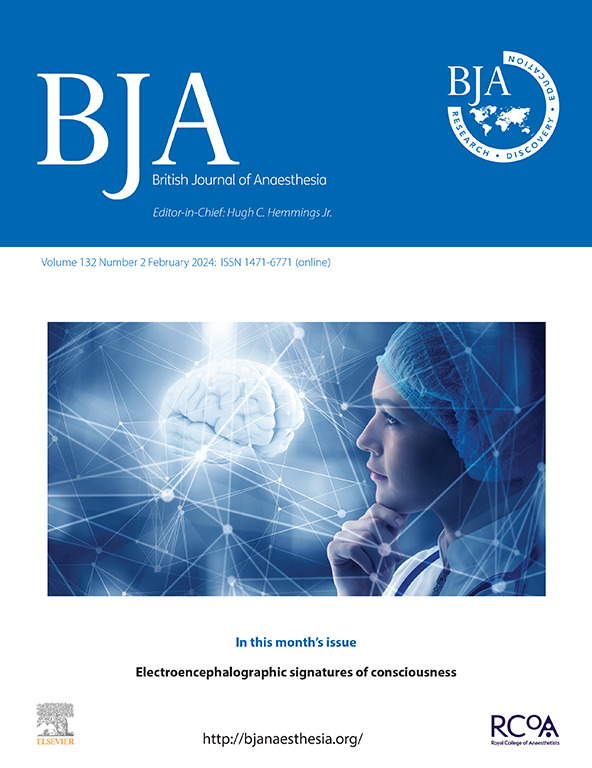Association of intraoperative hypotension and cumulative norepinephrine dose with postoperative acute kidney injury in patients having noncardiac surgery: a retrospective cohort analysis
IF 9.1
1区 医学
Q1 ANESTHESIOLOGY
引用次数: 0
Abstract
Background
Intraoperative hypotension is associated with acute kidney injury (AKI). Clinicians thus frequently use vasopressors, such as norepinephrine, to maintain blood pressure. However, vasopressors themselves might promote AKI. We sought to determine whether both intraoperative hypotension and cumulative intraoperative norepinephrine dose are independently associated with postoperative AKI in patients undergoing noncardiac surgery.
Methods
This was a retrospective cohort analysis of 38 338 adult male and female patients who had noncardiac surgery. The primary outcome was AKI within the first 7 postoperative days. We performed adjusted multivariable logistic regression analysis to determine whether intraoperative hypotension (quantified as area under a mean arterial pressure [MAP] of 65 mm Hg) and cumulative intraoperative norepinephrine dose were independently associated with AKI.
Results
The median (25th percentile, 75th percentile) area under a MAP of 65 mm Hg was 0.09 (0.02, 0.22) mm Hg∗day in patients with AKI and 0.05 (0.01, 0.14) mm Hg∗day in patients without AKI (P<0.001). The cumulative intraoperative norepinephrine dose was 1.92 (0.00, 13.09) μg kg−1 in patients with AKI and 0.00 (0.00, 0.00) μg kg−1 in patients without AKI (P<0.001). Both the area under a MAP of 65 mm Hg (odds ratio 1.55 [95% confidence interval 1.17–2.02] per mm Hg∗day; P=0.002) and the cumulative intraoperative norepinephrine dose (odds ratio 1.02 [95% confidence interval 1.01–1.02] per μg kg−1; P<0.001) were independently associated with AKI.
Conclusions
Both intraoperative hypotension and cumulative intraoperative norepinephrine dose were independently associated with postoperative AKI in patients undergoing noncardiac surgery. Pending results of trials testing whether these relationships are causal, it seems prudent to avoid both profound hypotension and high norepinephrine doses in adults undergoing noncardiac surgery.
非心脏手术患者术中低血压和累积去甲肾上腺素剂量与术后急性肾损伤的关系:回顾性队列分析
术中低血压与急性肾损伤(AKI)有关。因此,临床医生经常使用血管加压剂,如去甲肾上腺素来维持血压。然而,血管加压药本身可能促进AKI。我们试图确定术中低血压和术中累积去甲肾上腺素剂量是否与接受非心脏手术的患者术后AKI独立相关。
本文章由计算机程序翻译,如有差异,请以英文原文为准。
求助全文
约1分钟内获得全文
求助全文
来源期刊
CiteScore
13.50
自引率
7.10%
发文量
488
审稿时长
27 days
期刊介绍:
The British Journal of Anaesthesia (BJA) is a prestigious publication that covers a wide range of topics in anaesthesia, critical care medicine, pain medicine, and perioperative medicine. It aims to disseminate high-impact original research, spanning fundamental, translational, and clinical sciences, as well as clinical practice, technology, education, and training. Additionally, the journal features review articles, notable case reports, correspondence, and special articles that appeal to a broader audience.
The BJA is proudly associated with The Royal College of Anaesthetists, The College of Anaesthesiologists of Ireland, and The Hong Kong College of Anaesthesiologists. This partnership provides members of these esteemed institutions with access to not only the BJA but also its sister publication, BJA Education. It is essential to note that both journals maintain their editorial independence.
Overall, the BJA offers a diverse and comprehensive platform for anaesthetists, critical care physicians, pain specialists, and perioperative medicine practitioners to contribute and stay updated with the latest advancements in their respective fields.

 求助内容:
求助内容: 应助结果提醒方式:
应助结果提醒方式:


